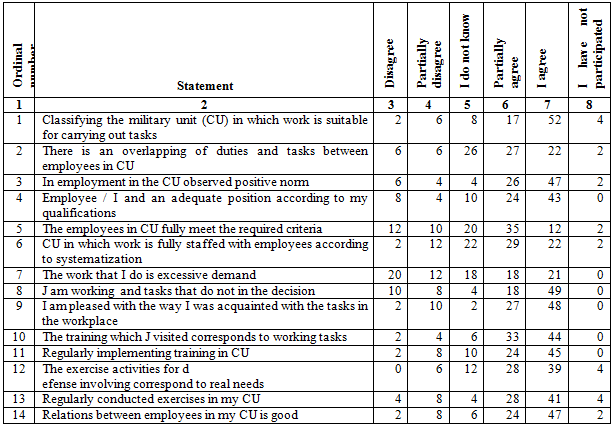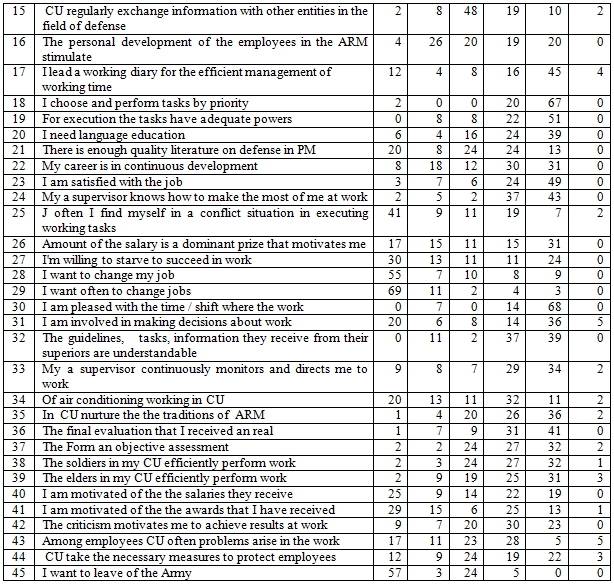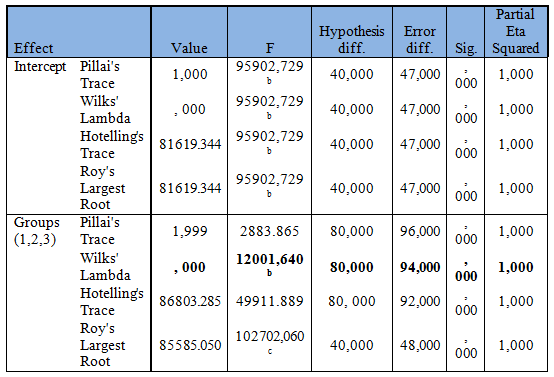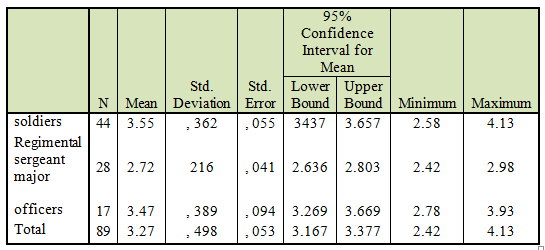СОВРЕМЕННОЕ УПРАВЛЕНИЕ ЧЕЛОВЕЧЕСКИМИ РЕСУРСАМИ ДЛЯ ЭФФЕКТИВНОГО И ДЕЙСТВЕННОГО ФУНКЦИОНИРОВАНИЯ АРМИИ РЕСПУБЛИКИ МАКЕДОНИЯ
Солунчевски М.1, Димовска-Котевска М.2
1 Министерство обороны, Международный славянский университет, доцент, доктор,
2 Международный славянский университет, доцент, доктор
СОВРЕМЕННОЕ УПРАВЛЕНИЕ ЧЕЛОВЕЧЕСКИМИ РЕСУРСАМИ ДЛЯ ЭФФЕКТИВНОГО И ДЕЙСТВЕННОГО ФУНКЦИОНИРОВАНИЯ АРМИИ РЕСПУБЛИКИ МАКЕДОНИЯ
Аннотация
Человеческие ресурсы являются сегментом управления , который включает последовательное проведение многих этапов, начиная от обеспечения занятости человеческих ресурсов до их выхода из организации или системы.Македонская армия является вооруженными силами всех граждан республики. Главная функция армии - защищать суверенитет и территориальную целостность республики. Человеческие ресурсы (HR) являются самыми важными из всех ресурсов в армии. Эффективность и достижение главной функции армии зависит от человеческих ресурсов. Соответственно, современное управление человеческими ресурсами важно для эффективного функционирования армии республики Македония.
Ключевые слова: управление, человеческие ресурсы, армия республики Македония
Solunchevski M.1, Dimovska-Kotevska M.2
1 Ministry of Defence, International Slavic University, Associate Professor, Doctor of Management,
2 REK, International Slavic University, Associate Professor, Doctor of Psychology
MODERN MANAGEMENT OF HUMAN RESOURCES FOR EFFECTIVE AND EFFICIENT FUNCTIONING OF THE ARMY OF THE REPUBLIC OF MACEDONIA
Abstract
Human resources are a segment of the overall management which involves sequential conduction of many steps starting from providing employment or human resources up to their leaving the organization or system. Macedonian Army is an armed force of all citizens of the Republic. A main feature of the Army is defending the sovereignty and territorial integrity of the Republic. Human resources (HR) are the most important of all resources in the Army. Effective and efficient achievement of its crucial function of the Army depends on human resources. Accordingly, modern management of human resources is essential for effectiveness and efficient functioning of the Army of the Republic of Macedonia.
Keywords: management, human resources, Army of Republic of Macedonia
INTRODUCTION
Human Resource Management (HRM) is a segment of the overall management. HRM implementation sequence involves the following functions: providing security, development, activation or deployment and maintenance of HR in an organization or system.
Providing HR as a component of HRM is a function of harmonization of quantitative and qualitative needs of the work of the organization and competence of potential candidates and future service needs of specific job functions.
Human resource development is a function of the external changes that require employees to effectively and efficiently meet client’s requirements and internal changes in individuals who spontaneously are occurring as experiential learning, which increases employment and the creative capacity of each individual.
Activation of the HR is the process of transforming the potential of each person into the work required and making an appropriate action. It involves:
Maintenance of HR for satisfying the primary, existential needs of employees and appropriate exercise of the principle of fairness in the exchange between the organization and the employee in their mutual partnership.[SC-2007-37]
The Macedonian Army (ARM) is an armed force of the Republic of Macedonia. The army is organized, ready and capable of running armed battles and combat and other actions for achieving its constitutional function of defense of the Republic. ARM has a permanent and reserve force. The permanent standing within the Army is composed of officers, noncommissioned officers, soldiers and civilians.[LD-no-185/2011]
The subject of this research work is in the permanent HRM within the Army or officers, noncommissioned officers (NCOs) and professional soldiers.
GENERAL NOTES FOR THE CONTEMPORARY MANAGEMENT OF HUMAN RESOURCES
HRM implementation sequence involves the following functions: providing security, development, activation or deployment and maintenance of HR in an organization or system.
Providing HR as the initial component of HRM represents professional accomplishment the following sub-functions:
- Analysis of the work in terms of educational needs at the level of organization, sector and specific job, such as changed circumstances in the social and legal environment, and also because of internal changes;
- HR planning in their quantitative and qualitative dimension, and
- Staffing of each job or complex task with competent and responsible employees.[SC-2007-55-82]
The development of HR as a function of HRM contains the following sub-functions:
- Work introduction to the following information: general, referring to the daily work; and Report for the history of the organization, its goals and mission, existing services and the place of their work in organizational goals, and detailed presentation, perhaps in the form of a brochure about the benefits, rules and policies of the organization.[KT-2005-268]
-training-like process which aim in acquiring specific knowledge, skills and abilities related to work and tasks and their application in practice during the work process. The training is categorized into three groups of factors: basic training, further training and implemented training or exercises.[WC-1989-181]
- Career development of HR which are categorized into four groups of factors that determine individual career. Also: Competence and knowledge, values and life goals, personal style, style and behavior of each person and knowledge of the opportunities and providing access to them for realizing their own career.[NT-1994-355]
Activation of HRM means taking the following steps:
- Shaping the work as a way of securing job satisfaction;
-Motivational strategies for current activation, defining of each performance enforcer (setting clear and measurable goals), enabling performance (providing resources for each executor) and encouraging performance (providing timely awards that were carried by the employees that are consider valuable)
-evaluating the performance of each executive order with giving appropriate feedback (educational, stimulating and corrective).[SC-2007-135]
Maintenance of HRM is accomplished through the following sub functions:
-Compensation of the employees (salaries, benefits, allowances, working conditions).[KC-2001-85]
- Disciplining and counseling to those substandard, of how they perform their duties or intentionally disrupt workflow.[GB-1995-355]
- regulating the labor relations (union organizing).[RG-2004-228-231]
-protection at work and other measures of supporting staff.[KC-2001-177]
HUMAN RESOURCE MANAGEMENT IN THE ARMY OF REPUBLIC OF MACEDONIA
HRM of the ARM is part of HRM in the defense and contains all the features and sub functions of HRM.
Providing human resources effectively and efficiently functioning of the ARM involves: analyzing the work, planning, recruitment, selection and employment of people in the Army.
Analyzing the work in ARM is carried out in accordance with the features of the defense system, the duties which ARM cadets have in the defense system, the assessment of vulnerability of the Republic of Macedonia and obligations arising from the request for participation for full membership in NATO.
Planning is made on the bases on classifying ARM and vacancies in the existing organization.
HRM staffing in the ARM is planned to be done using internal and external means. Internal way is done through internal redeployment of staff. Utility jobs are performed in accordance with the Law on Service in the Armed Forces and Employment Law, and laws pertaining to the processes of recruitment, selection and selection of applicants.
Recruitment begins with determining the specific needs of human resources in the Army announcing job openings or announcement of an internal competition for filling vacant or unfilled jobs.
The selection is made on the basis of applicants for job recruitment. For internal job position filling, selection is made from the available human resources.
The selection and recruitment in the Army is performed by education, psycho-physical ability and work experience. Employment is made on the account of the ethnic and gender representation.
Employment in the Army is performed based on the available HR. The records about the available human resources are managed in information systems to keep track of human resources: Ministry of Interior, Employment Agency and the Ministry of Defense. Additional information about HR is obtained from educational institutions and other entities.[LA-no-36/2010]
Human resource development in the defense system consists of the following steps: induction, training and career development.
The introduction of HRM work is done in the following way. Firstly, they are introduced to the management structures of the mission, goals and objectives of the responsible entities within the Army. Then management staff (officers and NCOs) introduces his employees for whom they are responsible.
HR training is mandatory for the defense. Accordingly, training in the Army is also mandatory. There are more types of training. Diversity training stems from the number and diversity of species and gender and ARM services and their tasks. Defense training is organized and carried out in the country and abroad. The country pursues training in Army units and training centers. Training abroad is realized in the institutions and bodies of NATO partners and through other institutions, agencies and their programs.
The training is accomplished as: basic, additional and or practical exercises. Through basic training HR knowledge for the defense system and the duty we have in force, assets and equipment and their practical use. Through additional training HR expand and deepen knowledge acquired in basic training. Exercise activities aim to complete training and headquarters units for fast and perform tasks in complex environments in peace and in war. The training also shared individual and collective training.[GTARM-Mod-2010]
Development is done through programs for human resource development. Programs are implemented through multiple methods and among the more important methods of training and development for employees of the ARM are: courses, seminars, counseling, transfer of authority, conferences, computer programs, etc. The development of the ARM defense is conducted by College[GGTARM-VA-2010] and other educational institutions in the country and abroad.[ http://www.nato.int/structur/recruit/nato-bodies.html]
Career development for the ARM is looked as vertical and horizontal career. Vertical career means moving up the hierarchical ladder of vertical position, i.e. moving from one to another corps associated with the act. Horizontal career related pay system. Career Development is accomplished by scoring groups. The transition from one to another career development of great importance is the assessment of employees and length of service.[LATARM-no-36/2010-58-73]
Activation of the HR system defense is made following the next steps: delegating tasks and powers, motivational strategies and assessment of performance.
Delegation of duties and powers are particularly important for the efficient execution of the work of the army officers and soldiers in the Army. The significance is even greater because of the specificity of the work. Delegating powers and authority in the ARM is made orally and in a written form.
Motivational strategies are focused in two directions, first by defining the appropriate tasks in the workplace and through appropriate reward employees for performance. Appropriate motivational strategies are dimensioned for ARM.
Evaluation of the performance of the tasks is performed according to already established standards. Performance standards are presented in ARM more houses numerous measures, activities, forms, rules, procedures, norms etc. Among employees represented are three types of quality in HR, level of expertise, appearance and behavior and psychophysical skills with appropriate priority depending of workplace organization.[ LATARM-no-36/2010-199-201]
Maintenance of the HR in the ARM is made by the following steps: compensation of employees, disciplining and counseling, regulating labor relations and occupational safety.
Compensation of employees for completed tasks is carried through the payment system, compensation system of payment and other benefits. [LATARM-no-36/2010-192-198]
Disciplining and counseling is considered as a step in the direction for improvement of the work. Disciplining as a procedure is applied by taking sanctions to reduce substandard behavior characterized by the employees. The same is accomplished through the same material and disciplinary responsibility. Counseling is a lengthy process that includes planning activities, analysis and action for normalizing and improving efficiency in work and of the behavior of the employees.[ LATARM-no-36/2010-118-145]
Regulation of labor relations is based on the following attributes: openness, trust, mutual respect, authenticity, solidarity, support and collegiality. Work protection of the employees in the ARM is accomplished by taking measures and laws to protect their rights, health or the safety of workers. Intensive protection measures at work are taken for ARM especially when taking part in training exercises and international missions. .[ LATARM-no-36/2010-215-217]
Regarding the departure of HR from the ARM all possible forms of leaving are represented in the Army. In that sense leave of the HR from the ARM can be made on many grounds: retirement, leaving into another organization, leave under the employment office; departure from the organization because of penalties, self-initiative leave (fluctuation) etc. [ LATARM-no-36/2010-218-223]
From previous acknowledgments in the Ministry of Defense and Army still dominates the departure of the HR by retirement (regular and irregular), while other shapes of leave of the HR are minimally represented.[SM-2010-133-136]
ANALYSIS OF THE RESULTS FROM THE RESEARCH ABOUT MANAGEMENT OF HUMAN RESOURCES IN THE ARMY OF THE REPUBLIC OF MACEDONIA
- Sample of the research.
To display contemporary HRM in the ARM a research was conducted with 89 respondents’ deployed units in the Army throughout. Among the respondents there were 44 soldiers, 28 NCOs and 17 officers, a copy of which corresponds to the pyramid hierarchy of the Staff. The research was conducted in 2012.
For the respondents, 45 statements are prepared. Respondent’s statements have five degrees of agreement: strongly disagree, partly disagree, I do not know, partly agree and disagree.
- Techniques and Methods of Research
The veracity of the statements of the respondents is conducted by comparison of the three groups using Univariant analysis and Multivariant.
By Univariant analysis and Multivariant (MANOVA / ANOVA) of the variance the differences are determined in estimates of the statements given between three groups of subjects (soldiers, NCOs and officers). The assessment is done by applying five-degree scale in which individual estimates give a total of 89 respondents (soldiers = noncommissioned (NCO) officers=28, and officers = 17), a total of 45 survey questions.
Data processing is performed in the SPSS analysis program.
Table 1 Overview of results of the the statements of staff officers, NCOs and soldiers (respondents) in the ARM
Multivariant analysis of variance (MANOVA)
From the inspection of table 1 where the results of the multivariate variance analysis (MANOVA) the assessment of the survey among the three groups of subjects (soldiers, NCOs and officers), it is determined that there are significant differences in the level of significance of 50.0 in the whole analyzed area. Based on the given results Wilk 's Lambda equals 0.000, which with the F - test, degree of freedom (F, 80 and 94 = 12001.6) and the partial ETA- square value 1.00 gives significant difference p - level = 0.000 (Sig = .000) of the examined area.
Table. 2 Multivarijantna analysis of data on respondents
Multivariate Tests
Univariant analysis of variance (ANOVA)
Summative assessment is being made with the questionnaires assessed by the survey respondents in each group separately (soldiers, NCOs and officers).
Based on the applied invariant analysis (ANOVA) of variance, statistically significant difference at 0.05 can be concluded, in the research applied between variables (summative assessment survey questions among the three groups).
From the inspection in the table 2 it may be noted that the middle value of the completed values from the estimation of all survey questions (summative) of the respondents the NCO group saw the lowest values (M = 2.72, SD = .216) unlike the group of officers (M = 3.47, SD =. 389) and the group of soldiers (M = 3.55, SD =. 362) where noted were the highest values in the assessment.
Table. 3 Univariate analysis of data on respondents
Descriptives’
From the inspection of the table 3 significant statistically differences can be ascertained at the level of .005% between the groups (soldiers, NCOs and officers) to which the results do not indicate, significance, p - level = 0.000 (Sig = .000) and F-test, F (2,86) = 57,81.
Table. 4 Overview of statistically significant differences between respondents
ANOVA
- Discussion
According to these comparisons between the three groups of respondents and the respondents' statements the following joint conclusions for each function of the HRM uniformed Staff can be taken out.
Providing in the HR. Respondents consider systematization in military unit (MU) ARM is appropriate. Part of respondents detected overlaps in certain tasks between jobs. The procedure in respect of employment is transparent. In the present moment can be observed in certain cases deviations in the staffing jobs with competent employees, and some places are still not filled. The work assignment are adequately dimensioned according to the workplaces except for the Officers who believe that the work load that they have is too much. Whereas the soldiers agree that they sometimes perform tasks that are not in their job classification.
Development of the HR. The employees in the ARM regularly and appropriately are informed about the work. Employees are satisfied with the Army way of work induction. ARM has the most effective and most efficient system for training and exercise activities in the country. The officers, soldiers and NCOs regularly conduct training and exercises. Training and exercise activities are accomplished in the country and abroad in NATO structures. Training and exercise activities correspond to the real needs and objectives. Training and exercise activities are of different types.
Divided are the opinions of respondents about the available conditions for personal development of HR in the ARM. A large percentage of respondents consider that here isn’t enough quality literature in the field of security, defense and protection in the country. There are respondents who think that their career is in continuous development. Such attitudes are more pronounced among NCOs and soldiers.
Activation of the HR: Delegation of powers and duties regularly and adequately is realized formation of ARM. Delegating tasks and powers in defense are realized in writing and orally. Officers, NCOs and soldiers indicated that they fully agree with the appropriateness of the powers with which they have to carry out tasks. The superiors have competencies and are motivated in order to make the most of the employees which are involved in performing the task. The employees, the directions, tasks, and information they receive from their superiors are understandable and there is a chance for feedback in interpersonal communication. It allows employees to choose and perform tasks according to priority from most important to less important tasks.
Most of the employees are satisfied with the time change and they work, but not all adequately involved in decision making. Soldiers partially disagree on how involved in making decisions related to their work.
The dominant majority of employees believe that everything is realistic estimates for work which they receive and the criteria on which assessment is performed. However there are dissatisfied with the assessment, visit under the officers and soldiers. Respondents are sure that everything is completely objective evaluation criteria. In the evaluation consider equality dominates the ratings in certain cases is demotivating.
There is confrontation between officers and soldiers in terms of efficiency of performance. Many elders believe that soldiers have weaknesses in the performance of job performance, or fully or partly agree but disagree with their studies in the performance of soldiers in performance. The same conclusion soldiers have for their elders.
Maintenance of HR. Military officers and soldiers according to their competencies agree that jobs and time or change in working. The system of wages and benefits does not fully represent the model of fairness. Military officers agree about the amount of salary, while soldiers partially disagree. In terms of rewards and benefits for the work, attitudes are confronted. From the rewards, most satisfied are the officers until after the hierarchical ladder NCOs and soldier’s pleasure decreases. The ARM nurtures battle traditions, all aimed at fostering and development of the the military culture. However in view of the work environment as one aspect of culture is confronted perceive attitudes among the three groups of respondents. In all structures equally respondents noted five types of statements completely agree to completely disagree with the contention Air work in MU.
As to the measures taken for legal and physical protection of employees in the MU, opinions are divided. There are employees who do not agree, against employees like and agree with the measures taken to protect by WPP. The agreement is more pronounced among military officers in terms of soldiers.
Dominating number of the employees in the ARM did not want to leave the Army, but there are nearly one third who do not know whether they want or do not want to leave the Army. That percentage is equally represented in all three categories this percentage sigalizira certain dissatisfaction, but not yet significant.
Employees in the ARM do not want to leave the Army. Departure from the dominant Army happens only because of retirement. Minimal is the number of HR that leave because of maldiscipline and punishment, voluntarily leave or to obtain a better job.
CONCLUSION
Human resources are the most important resources in the Army. The HR of the ARM comprises of: officers, NCOs, soldiers and civilians. HR Management in the Army means providing development, activation and maintenance of HR. Effectively and efficiently perform these functions of the MHR in the ARM is crucial for effective and efficient functioning of the Army and defense of the sovereignty and territorial integrity of the Republic Macedonia.
A survey conducted in 2012 by the officers, NCOs and professional soldiers’ answers for HRM of ARM.
Ensuring HR is done based on a good analysis of the work, proper planning and filling the blank and competent employees.
Newly employed people regularly are informed about the work of their superiors. For successful execution of tasks regularly attend training and exercising. Training and exercise activities correspond to the actual needs. The Army should make an effort to improve conditions for personal development of employees through under determining spatial, technical capabilities and capacities in the relevant literature.
Delegation of powers and duties regularly and is properly realized in ARM. The superiors have the competence and are motivated to make the most of the employees in performing their tasks. Feedback is needs in order to ensure more efficiently performance of the tasks. The criteria for evaluating and assessing employees are real and more demotivating than motivating.
Military officers and soldiers according to their competencies agree that jobs and the time at work. There is full compliance with the salary level and distribution of prizes. Divided are the opinions among staff about the adequacy of the legal and physical protection of jobs. However, the number of employees who have left or would like to leave the Army is very minimal.
From the above said can be done only conclusion that modern HRM in the ARM creates real prerequisites for effective and efficient realization of the basic functions of the ARM defense of sovereignty and territorial integrity of the Republic of Macedonia
References
- Graham HT, Bennett, R., Human Resources Management, Longman Group-UK-Ltd-1995 .
- Elaborative work for unification of the curriculum for I cycle studies at the Military Academy- VA-Skopje- 2012.
- Curriculum for II cycle studies (specialized and postgraduate)- VA- Skopje-
- Law for Defense (regulated text) Official Gazette of RM- no-185/2011
- Law for Army training in the ARM, Official Gazette of RM- no- 36/2010
- Kralev, T., Bases of management, fourth edition, Skopje- CIM- 2005.
- Kelvin C ., Matering Human Resource Management- Palgrave-
- Noel, M., Tichy , Managing Strategic Change, Skaj- Skopje-
- Rakocevic, G., Management of Human Resources in the tourism and hospitality- Ohrid- 2004.
- Smilevski, C. et al., Management of HR, pilot version, Detra- Skopje- 2007.
- Soluncevski, M., Organization and management of PEO, ORORM- Skopje- 2010.
- Guidelines for guiding the training in the Army of Republic of Macedonia, MoD-ARM- Skopje- 2010.
- Wayne, F., Casio Managing Human Resources, Productivity, Quality of Work Life, New York: Profits McGrow, Hill Book Company, 1989, ( Translation from ISPPI- Center for management development and HR)- Skopje- 1997.
- http://www.nato.int/structur/recruit/nato-bodies.html





